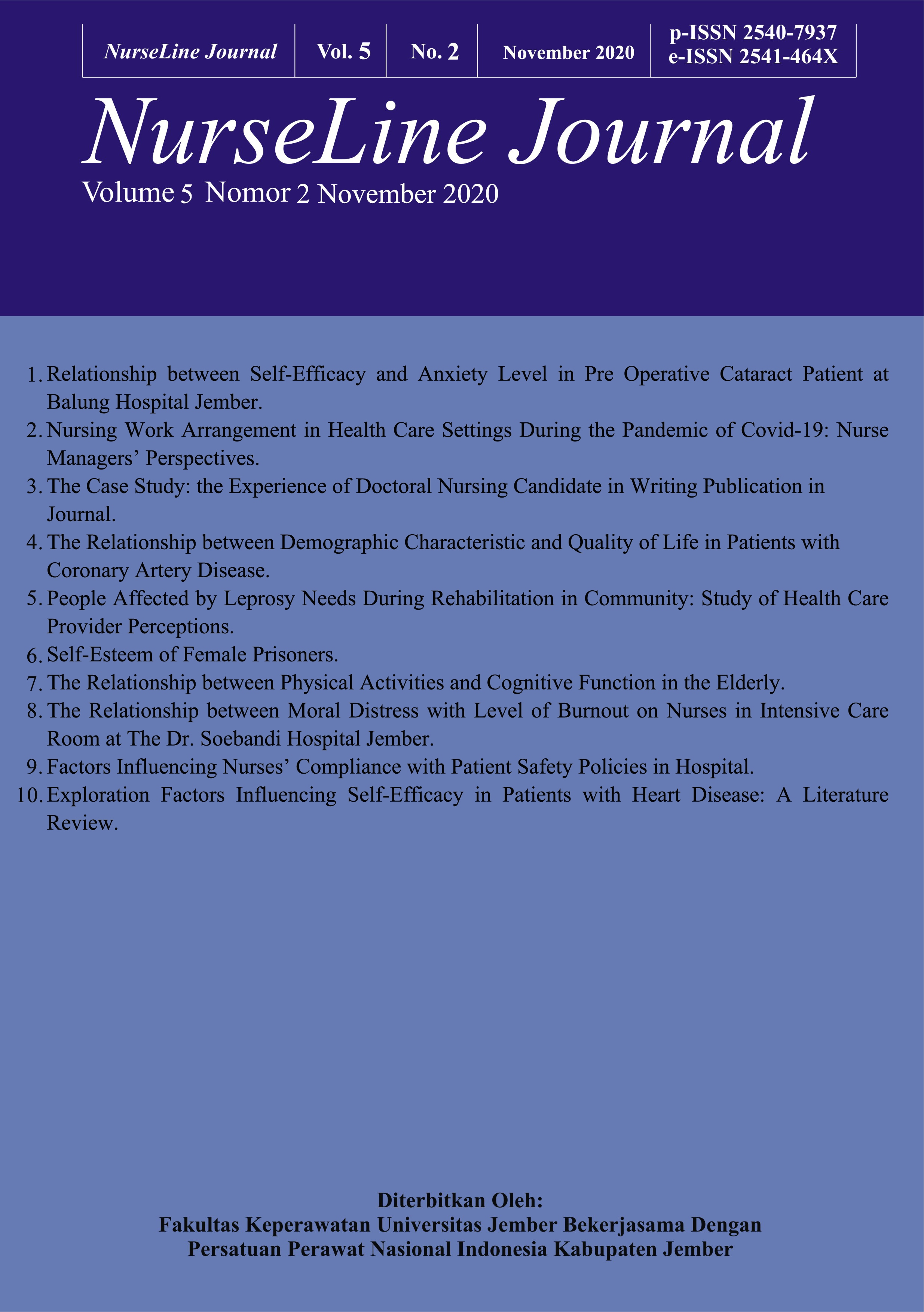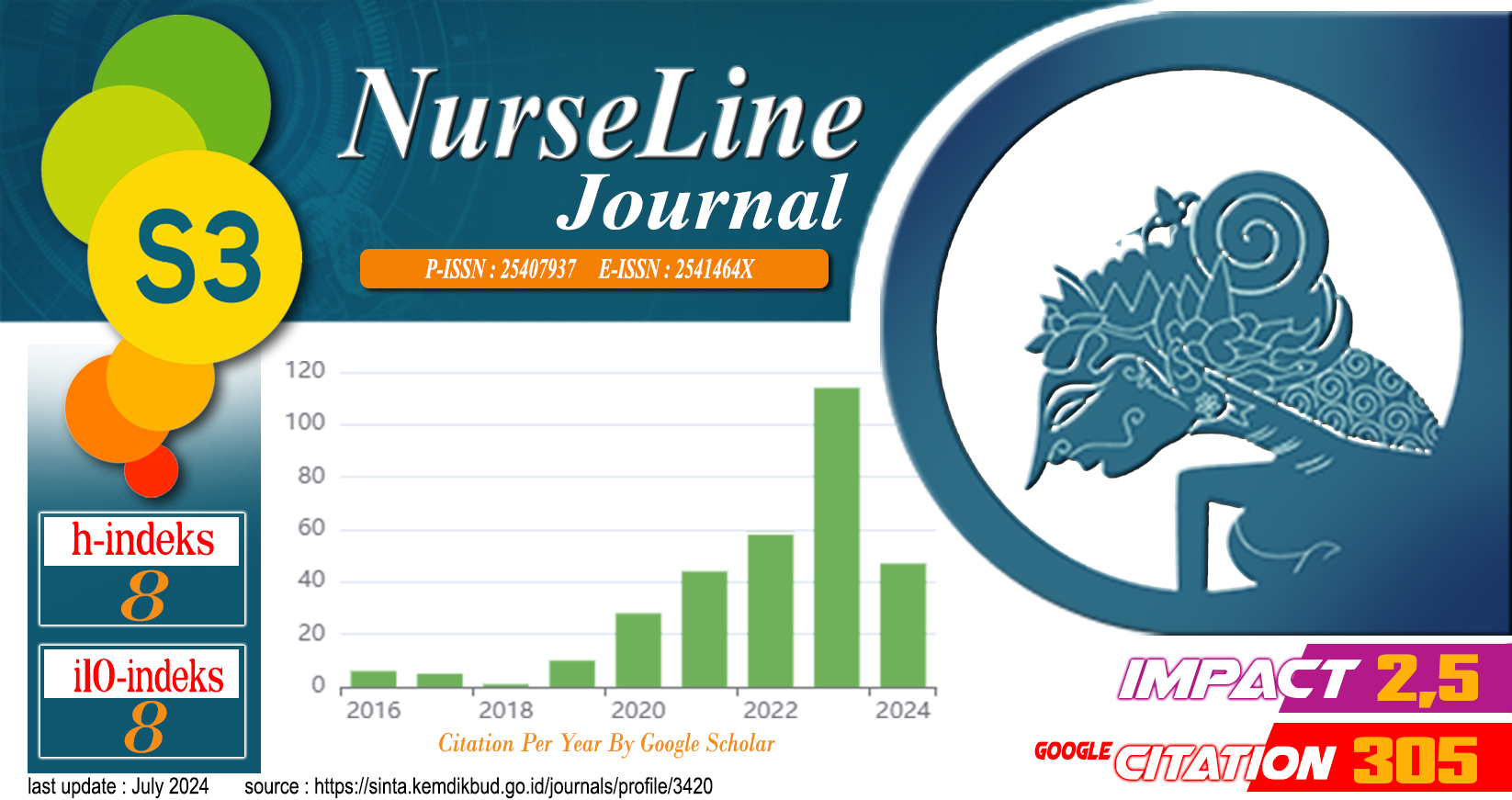Self-Esteem of Female Prisoners
Abstract
Female prisoners are special communities that are vulnerable to a decline in self-esteem. The purpose of this study is to describe the self-esteem of female prisoners in Semarang female prisons. Researchers used descriptive designs in this study. The results showed that the most women prisoners' self-esteem were moderate self-esteem (81.0%), high self-esteem (16.5%), and low self-esteem (2.5%). Most female prisoners experience a decrease in self-esteem, so that various efforts are needed to improve the self-esteem of female prisoners, especially community-based nursing interventions.
References
Bai, Q., Lin, W., & Wang, L. (2016). Family incivility and counterproductive work behavior: A moderated mediation model of self-esteem and emotional regulation ☆. Journal of Vocational Behavior, 94, 11–19. https://doi.org/10.1016/j.jvb.2016.02.014
Bruce, D., & Larweh, E. (2017). Self-esteem, needs satisfaction and psychological well-being of inmates at James Camp Prison in Ghana. International Journal of Humanities Social Sciences and Education (IJHSSE), 4(9), 32–39. https://doi.org/10.20431/2349-0381.0409005
Cannon, E. A., Bonomi, A. E., Anderson, M. L., Rivara, F. P., & Thompson, R. S. (2010). Adult health and relationship outcomes among women with abuse experiences during childhood. Violence and Victims, 25(3), 291–305. https://doi.org/10.1891/0886-6708.25.3.291
Chen, X., Hannibal, N., & Gold, C. (2015). Randomized trial of group music therapy with Chinese prisoners: Impact on anxiety, depression, and self-esteem. International Journal of Offender Therapy and Comparative Criminology, 1–18. https://doi.org/10.1177/0306624X15572795
Crabtree, J. W., Haslam, S. A., Postmes, T., & Haslam, C. (2010). Mental health support groups, stigma, and self esteem: Positive and negative implications of group identification. Journal of Social Issues, 66(3), 553–569.
Damian, R. I., & Robins, R. (2011). Self-esteem across the lifespan: Issues and interventions, edited by Mary H. Guindon. Journal of Women & Aging. https://doi.org/10.1080/08952841.2011.561147
Debowska, A., Boduszek, D., & Sherretts, N. (2016). Self-Esteem in adult prison population: The development and validation of the self-esteem measure for prisoners (SEM-P). Deviant Behavior, 00(00), 1–12. https://doi.org/10.1080/01639625.2016.1246034
Falk, Ö., Sfendla, A., Brändström, S., Nilsson, T., & Kerekes, N. (2016). personality and trair aggresion profiles of male and female prison inmates. Psychiatry Research. https://doi.org/10.1016/j.psychres.2016.12.018
Fennell, M. J. V. (2014). Cognitive therapy in the treatment of low self-esteem. Advances in Psychiatric Treatment, 4, 296–304. https://doi.org/10.1192/apt.4.5.296
Garofalo, C., & Velotti, P. (2016). Alcohol misuse in psychiatric patients and nonclinical individuals : The role of emotion dysregulation and impulsivity Alcohol misuse in psychiatric patients and nonclinical individuals : The role of emotion dysregulation and impulsivity. Addiction Researc & Theory, 6359(July). https://doi.org/10.3109/16066359.2014.987758
Ginting, E. M., & Lubis, R. (2017). Hubungan antara harga diri dan tingkat pendidikan dengan sikap penerimaan ibu baru terhadap anak autis di Yayasan I-Home Schooling Medan. UMA, 36–43.
Hajar, S. (2017). Hubungan harga diri dengan kualitas hidup narapidana di lembaga pemasyarakatan narkotika kelas IIA Yogyakarta. Naskah Publikasi Universitas ’Aisyiyah Yogyakarta.
Hariadi, N., Agustina, D. M., & Murjani. (2015). Hubungan antara sikap keluarga dengan dukungan keluarga terhadap penderita skizofrenia di wilayah kerja Puskesmas Pekauman Banjarmasin. Naskah Publikasi Stikes Suaka Insan Banjarmasib, 20.
Hidayati, N. A. (2015). Pengaruh Tingkat Pendidikan Orang Tua terhadap Self-Esteem Remaja. Seminar Psikologi Dan Kemanusiaan, 978–979.
Hidayati, N. O., & Sutini, T. (2017). Gambaran harga diri warga binaan perempuan di Lembaga Pemasyarakatan X Bandung. Jurnal Keperawatan BSI, 5(1), 1–7.
Igomu, A. C., & Mayange, R. (2013). Relationship between self-esteem and personal development of prison inmates in Jalingo, Taraba State Nigeria. Journal of Education and Practice, 4(4), 277–283.
Juniartha, I. G. N., Ruspawan, I. D. M., & Sipahutar, I. E. (2012). Hubungan antara harga diri (Self-Esteem) dengan tingkat stres narapidana wanita di Lapas Kelas IIA Denpasar. Coping Ners Jurnal, 2392–1298(2012).
Kalemi, G., Michopoulos, I., Efstathiou, V., Tzeferakos, G., Gkioka, S., Gournellis, R., & Douzenis, A. (2019). Self-esteem and aggression in women: Differences between female prisoners and women without criminal records. Women & Health, 0(0), 1–13. https://doi.org/10.1080/03630242.2019.1593284
Kamody, R. C., Thurston, I. B., Decker, K. M., Kaufman, C. C., Sonneville, K. R., & Richmond, T. K. (2018). Relating shape/weight based self-esteem, depression, and anxiety with weight and perceived physical health among young adults. Body Image, 25, 168–176. https://doi.org/10.1016/j.bodyim.2018.04.003
Khodabakhshi, K., Mohammadi, N., Taghavi, M., & Rahimi, C. (2015). Study of effectiveness integrated spiritual-cognitive-behavioral group therapy with Islamic Mysticism approach of anxiety and self esteem. UMP Social Sciences and Technology Management, 3.
Kolubinski, D. C., Frings, D., Nik, A. V, Lawrence, J. A., & Spada, M. M. (2018). A systematic review and meta-analysis of CBT interventions based on the Fennell Model of low self-esteem. Psychiatry Researc, 267(June). https://doi.org/10.1016/j.psychres.2018.06.025
Komoyo, J. M. (2018). Effects of imprisonment on self-esteem among female inmates in selected prisons in Kenya. European Scientific Journal, 14(17), 165–173. https://doi.org/10.19044/esj.2018.v14n17p165
Kusuma, Y. L. H. (2015). Pengaruh bimbingan metode diskusi terhadap perubahan harga diri narapaidana di Lapas Kelas IIB Kota Mojokerto. Hospital Majapahit, 7(2), 55–67.
Li, H. C. W., Chan, S. L. P., Chung, O. K. J., & Chui, M. L. M. (2015). Relationships among Mental Health , Self-esteem and Physical Health in Chinese Adolescents An exploratory study. Journal of Health Psychology, 15 (1)(96–106). https://doi.org/10.1177/1359105309342601
Maharani, L., Putri, D. E., & Banoeo, A. S. (2018). Hubungan harga diri dengan depresi narapidana remaja di Lembaga Pemasyarakatan Kelas IIA Padang. Naskah Publikasi Universitas Andalas.
Maryatun, S., Hamid, A. Y. S., & Mustikasari. (2014). Logo terapi meningkatkan harga diri narapidana perempuan pengguna narkotika. Jurnal Keperawatan Indonesia, 17(2), 48–56.
McManus, F., Waite, P., & Shafran, R. (2009). Cognitive-behavior therapy for low self-esteem: A case example. Cognitive and Behavioral Practice, 16(October 2017). https://doi.org/10.1016/j.cbpra.2008.12.007
Mili, P. M. K., & Cherian, N. S. (2015). Female Criminality in India : Causes and Preventive Measures 1. International Journal of Criminal Justice Sciences, 10(1), 65–76.
Parilti, N., & Tunc, T. (2018). The effect of self-esteem and trait anxiety on bandwagon luxury consumption behavior: Sample of a state and private University. Abasyn Journal of Social Sciences, 11(2), 254–279.
Poston, B. (2009). Hierarchy of Needs, (August), 347–353.
Rosenberg, M. (1956). Self-esteem and concern with public affairs, 55.
Rosenberg, M., Schooler, C., Schoenbach, C., Rosenberg, F., & Rosenberg, M. (2011). Global self-esteem and specific self-esteem: Different concepts, differents outcomes. JSTOR American Sociological Review, 1995, Vol. 60 (February:141-156) 141-156, 60(1), 141–156. Retrieved from http://www.jstor.org/stable/2096350
Saputra, D. D., Azza, A., & Suryaningsih, Y. (2016). Hubungan dukungan keluarga dengan harga diri narapidana di lembaga pemasyarakatan klas IIA Jember. Naskah Publikasi Universitas Muhammadiyah Jember.
Schanz, Y. Y. (2017). The relationship between aggression and self-esteem among prison inmates. Journal of Aggression, Maltreatment & Trauma, 00(00), 1–17. https://doi.org/10.1080/10926771.2017.1331940
Schunk, D. H., & Zimmerman, B. J. (2012). Motivation and self regulated learning: Theory, research, and applications. London: Lawrence ErlbaunAssociates.
Sickel, A. E., Seacat, J. D., & Nabors, N. A. (2016). Mental health stigma: Impact on mental health treatment attitudes and physical health. Jurnal of Health Psychology. https://doi.org/10.1177/1359105316681430
Suendra, D. L. O., Setiabudhi, I. K. R., & Suardana, I. W. (n.d.). Proses pembinaan terhadap narapidana narkoba di Lembaga Pemasyarakatan Kelas II A Kerobokan. Kertha Semaya, Vol. 1 No., 1–9.
Taylor, T. L., & Montgomery, P. (2007). Can cognitive-behavioral therapy increase self-esteem among depressed adolescents? A systematic review. Children and Youth Services Review, 29, 823–839. https://doi.org/10.1016/j.childyouth.2007.01.010
Torkaman, M. (2018). Relationship between adaptation and self-esteem in addicted female prisoners in the south east of Iran. International Journal of Adolescent Medicine and Heakth, 1–8. https://doi.org/10.1515/ijamh-2017-0168
Torkman, M., Miri, S., & Farokhzadian, J. (2016). Self-esteem of imprisoned female addicts: Is it important to community health? Shiraz Electronic Medical Journal, (December), 58663. https://doi.org/10.5812/semj.58663
Ulfa, G. (2018). Hubungan antara stres, harga dirim dan dukungan sosial terhadap kesejahteraan psikologis pada lanjut usia. Naskah Publikasi Universitas Muhammadiyah Surakarta.
Utari, D. I., Fitria, N., & Rafiyah, I. (2013). Gambaran tingkat kecemasan pada warga binaan pemasyarakatan wanita klas II A Bandung. Jurnal Ilmu Keperawatan, (1), 1–7.
Widyantoro, A. (2016). Hubungan antara religiusitas dengan kepercayaan diri. Jurnal Psikologi Islam Al-Qalb, (January), 1–7.
Yulianti, T. S., Meilina, W., & Wijayanti, P. (2016). Hubungan tingkat pendidikan dengan tingkat pengetahuan tentang kesehatan jiwa dengan sipak masyarakat terhadap pasien gangguan jiwa di RW. XX Desa Duwet Kidul Baturetno Wonogiri. Kosala, 4(1), 1–12.

This work is licensed under a Creative Commons Attribution-ShareAlike 4.0 International License.
















